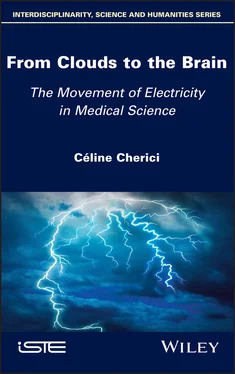In a gendered tradition of understanding hysterical symptoms, he described passions in women that “…accumulate too much fire principle in the brain, & dispose them to frequent convulsive outbursts” [PET, 87, p. 91, author’s translation].
These points developed by Petetin are interesting. Indeed, when Henri Gastaut (1915–1995) tried to outline a typology of electroencephalographic tracings [ADR 54] in connection with archetypal personalities, we find the way in which these links between the nervous system and electricity developed.
Then in 1803, Cassius explained on the one hand the direct effects of galvanism on subjects and on the other hand the link between temperament, in the psychological sense of the term, and the ability to be stimulated by galvanism. The notion of temperament refers to a trait of character as well as to a link with the supposedly singular strength of the nervous fluid specific to each individual:
Among the influences that Galvanism exerts on the animal economy are the acid and sometimes alkaline taste, the production of lightning, the pain one feels, the involuntary movements one makes when touching the galvanic devices, the convulsive state into which it plunges those with the very irritable nervous type. [CAS 03, pp. 22–23, author’s translation]
Experiments were made to discover, or not, the singularities of the nerves of people suffering from “electrical diseases”:
When an epileptic died, I had a surgeon cut some of his nerves, and I also got similar ones from another corpse which had not been subject to nervous diseases during his lifetime. These nerves being well dried out I rubbed them in the dark & I saw a lot of electric light, between the rubbing & the nerves of the one who had been subject to spasmodic movements; I saw very little of it in the nerves drawn from the second body. The nerves of a person prone to spasms are therefore more electric than those in whom one has never, ever noticed similar convulsions as the experience I have made, & that I have repeated several times with the same success, having kept these nerves for more than two years. [PAL 47, p. 225, author’s translation]
One can wonder about this imaginary electrical singularity of an organism suffering from nervous disorders. It must be brought closer to the notion of a body designed as a natural electrical machine. If the sensitivity and excitability of the nerves depended on a personality marked by a more or less nervous temperament, the medical applications of galvanism were fairly quickly focused on nervous disorders. This fact influenced its reception in the medical world:
No doubt people of excessive nervous susceptibility are usually well served by a bath or simple galvanic current, so M. Labeaume’s method must be useful to patients with an eminently nervous constitution. [LAB 28, p. 25, author’s translation]
Also experimenting on human chains 15 , Humboldt quickly noticed the variability of conductivity from one person to another, which could be almost zero in some people. This observation completed the question of a subject’s electrical temperament; this temperament influencing both body and consciousness.
To conclude this chapter, here is a current scientific episode whose rigor is not to be judged, but to underline its inscription both in the long temporality adopted in this work and in a scientific imagining of the neuro-electric omnipotence. In 2016, a controversial article appeared on the Frankenstein effect. Canavero, known for his research in the field of human head transplants, using Aldini and Ure’s experiments, took up the following theme:
Data from two centuries ago prove that a fresh cadaver, after hanging or decapitation, can be mobilized by electrical stimulation for up to 3 hours. By administering spinal cord stimulation by applied paddles to the cord or transcranial magnetic stimulation to M1 and recording evoked potentials, it should be possible to test fusogens in fresh cadavers. Delayed neuronal death might be the neuropathological reason. [CAN 16]
It is doubly relevant to the history of cadaver experiments: on the one hand, a fresh cadaver can serve as an experimental substitute for the animal model; on the other hand, it allows us to explore the neuropathological foundations of the process of dying. Canavero placed his research in the context of isolated neuronal cell cultures:
Testing on brain dead organ donors in the interval between declaration of brain death and initiation of organ harvesting is an ethical option. Reviewed data from two centuries ago prove that another ethical option is available, that is, experimentation on fresh cadavers. As discussed, movements can be elicited in a fresh cadaver by electrical stimulation for up to 3 hours (and possible more). This suggests that the cerebral cortex and its projections to the spinal cord and the cord itself remain viable for up to 3 hours postmortem. This includes both the cell bodies and the synapses. […] spinal cord stimulation above the level of attempted fusion or transcranial magnetic stimulation to M1 followed by recording motor evoked potentials (MEP) should be enough to confirm neuropshysiological conduction. [CAN 16]
While the scientific dimension seems to fall back into the spectacular and the announcement effect , it seemed relevant to point out the continuous resurgence of the electric imagining as a material for life.
Thus, an electrical culture, plastic and polymorphic, was born and evolved during the 19th Century: a spark of life, the guarantor of a moral order, the substrate of individual temperaments, it marked the history of physiology, medicine, philosophy and literature. The next chapters will look at how these different stages are broken down and how they give rise to knowledge, practices and techniques that are still relevant today.
1 1Bertholon alludes, in this passage, to the research of Nicolas, M. “Experiments made on some animals fallen into asphixia caused by coal vapors”, in Observations sur la physique, sur l’histoire naturelle et sur les arts, [NIC 86, p.231, author’s translation].
2 2The muscle referred to in this quote from Aldini is the heart.
3 3A Franco-Belgian physiologist, Nysten, together with Bichat, conducted pioneering electromedical experiments, particularly in connection with the determination of the stages of rigor mortis, described in 1811 and known as “Nysten’s law”. This research cannot be detached from experiments on the galvanization of the heart, nor can it be detached from investigations into the length of time the tissue retains potential excitability.
4 4To understand the atmosphere and the race of these physiologists and experimenters to obtain these bodies, it is exciting to read Nysten’s story of his adventure to arrive just at the moment when the tortured man gave his last breath. Thus he saw the announcement of execution, went urgently to the director of a medical school who could receive such a subject and assisted him in motivating the request: “I testify to him the desire that I have to try on the heart of man the experiments that I had already made on the hearts of several animal species. I add that we are going to torture a criminal, […] I obtain authorization by virtue of which the body of the person to be killed was placed at my disposal, after his beheading, […]. No sooner had I got there than I saw the fatal knife fall” [NYS 02, p. 18, author’s translation].
5 5Ultimum moriens is Latin for the last thing to die. In cardiac anatomy it describes the right chamber of the heart, considered as still susceptible to contraction after the rest of the heart and as the last part to stop.
6 6Historically, this debate is part of older quarrels about the respective places of the heart and the brain. Moreover, it accompanies the progressive cerebralization of faculties. “Such a relationship is not self-evident and has not been established without difficulty. Aristotle and his school located the center of sensations in the heart, and gave the brain, a cold and humid organ, the only function of tempering the body’s internal heat. The idea that the brain is the center of intelligence is found in a cursive and often metaphorical way among some Presocratics, Hippocrates and Plato. But it was Galen (131–200) who, refuting Aristotle, provided the first systematic demonstration of this, based on convergent anatomical and pathological arguments” [LAP 70, p. 599, author’s translation].
Читать дальше












